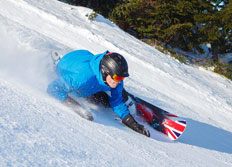
Skier’s thumb makes up about 10% of skiing injuries. This is an injury to one of the ligaments in the thumb. Ligaments are important because they stabilize bones to one another. In other words they keep our joints stable and moving correctly. This injury occurs most commonly when a skier falls with a ski pole in their hand. This is dangerous as is causes the thumb to overextend, stretching the ligament in the inner aspect of the thumb (think of trying to pull your thumb away from the index finger.) This puts a lot of stress on the ulnar collateral ligament resulting in a sprain or rupture. Sometimes a piece of the bone can be broken up and pulled away with the ligament.

The most common symptoms are tenderness, swelling and weakness along the inner aspect of the thumb at the first knuckle. The thumb will also lose some of its side-to-side stability. If the ligament is completely torn, the thumb will be so unstable at the first knuckle that it will bend to one side with little effort.
Treatment depends on the severity of the injury to the ligament. If the ligament is only partially torn then surgery is not necessary, unless the symptoms don’t improve with conservative care. Treatment consists of placing the hand in a cast designed to immobilize the thumb for a period of 4 weeks. This is followed by a 2-week period of immobilization using a removal splint so that range-of-motion exercises can be started. In the setting of a partially torn ligament, healing with full recovery can be expected.
When the ligament is completely torn, the joint is unstable and surgery is usually necessary. After surgery, the hand is placed in a cast to immobilize the thumb for several weeks. This is followed by a period of immobilization with a removable splint, during which time active range-of-motion exercises are begun. Activities that can stress the ligament should be avoided for 4 to 6 months following the surgery. Some tenderness and thickening of the inner aspect of the thumb at the first knuckle can be expected to persist for about one year following surgery.
If this injury is ignored a condition called Gamekeeper’s thumb can develop. This is considered a chronic injury to the same ligament of the thumb and results in great side-to-side instability of the thumb. The longer the injury exists, the more chance a more complicated procedure will be necessary.
To help prevent this it’s recommended to avoid putting your hands into the ski pole loops unless absolutely necessary. Some people also recommend thumb stabilizers to help protect the thumb ligaments without restricting range of motion.
*The views and opinions expressed herein are those of the author and do not necessarily reflect the views of MDLingo.com, its affiliates, or its employees.